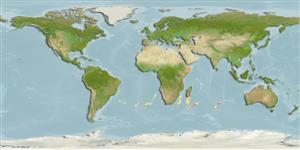Actinopterygii (ray-finned fishes) >
Perciformes (Perch-likes) >
Trichiuridae (Cutlassfishes) > Aphanopodinae
Etymology: Aphanopus: Greek, aphanes = hidden + Greek, pous = foot (Ref. 45335).
Environment / Climate / Range
Ecology
Marine; benthopelagic; depth range 905 - 2000 m (Ref. 6181). Deep-water, preferred ?; 23°S - 39°S, 54°W - 84°E (Ref. 6181)
Southeast Atlantic: Namibia and at Walvis Ridge. Southwest Atlantic: off Argentina. Indian Ocean: on seamounts off Mozambique and the West Australian Ridges. Western Pacific: Southeast Australia, North Island in New Zealand and the Challenger Plateau (Ref. 41692).
Size / Weight / Age
Maturity: Lm ? range ? - ? cm
Max length : 90.0 cm TL male/unsexed; (Ref. 36731)
Short description
Morphology | Morphometrics
Dorsal
spines
(total): 42 - 45;
Dorsal
soft rays
(total): 61-66;
Anal
spines: 2;
Anal
soft rays: 51 - 57;
Vertebrae: 111 - 117. Pelvic fins represented by a single spine in juveniles, inserted before the base of the pectoral fins, but entirely absent in adults. Body color is coppery black with iridescent tint. The inside of the mouth and gill cavities black.
Occurs on the continental slope or underwater rises (Ref. 10818).
Life cycle and mating behavior
Maturity | Reproduction | Spawning | Eggs | Fecundity | Larvae
Nakamura, I. and N.V. Parin, 1993. FAO Species Catalogue. Vol. 15. Snake mackerels and cutlassfishes of the world (families Gempylidae and Trichiuridae). An annotated and illustrated catalogue of the snake mackerels, snoeks, escolars, gemfishes, sackfishes, domine, oilfish, cutlassfishes,. scabbardfishes, hairtails, and frostfishes known to date. FAO Fish. Synop. 125(15):136 p. (Ref. 6181)
IUCN Red List Status (Ref. 115185)
CITES (Ref. 94142)
Not Evaluated
Threat to humans
Harmless
Human uses
Fisheries: of no interest
More information
Common namesSynonymsMetabolismPredatorsEcotoxicologyReproductionMaturitySpawningFecundityEggsEgg development
Age/SizeGrowthLength-weightLength-lengthLength-frequenciesMorphometricsMorphologyLarvaeLarval dynamicsRecruitmentAbundance
ReferencesAquacultureAquaculture profileStrainsGeneticsAllele frequenciesHeritabilityDiseasesProcessingMass conversion
Tools
Special reports
Download XML
Internet sources
Estimates of some properties based on models
Phylogenetic diversity index (Ref.
82805): PD
50 = 0.5078 [Uniqueness, from 0.5 = low to 2.0 = high].
Bayesian length-weight: a=0.00046 (0.00020 - 0.00105), b=3.12 (2.92 - 3.32), in cm Total Length, based on LWR estimates for this (Sub)family-body shape (Ref.
93245).
Trophic Level (Ref.
69278): 4.1 ±0.7 se; Based on size and trophs of closest relatives
Resilience (Ref.
69278): Low, minimum population doubling time 4.5 - 14 years (Assuming tmax>10).
Vulnerability (Ref.
59153): Low to moderate vulnerability (34 of 100) .
